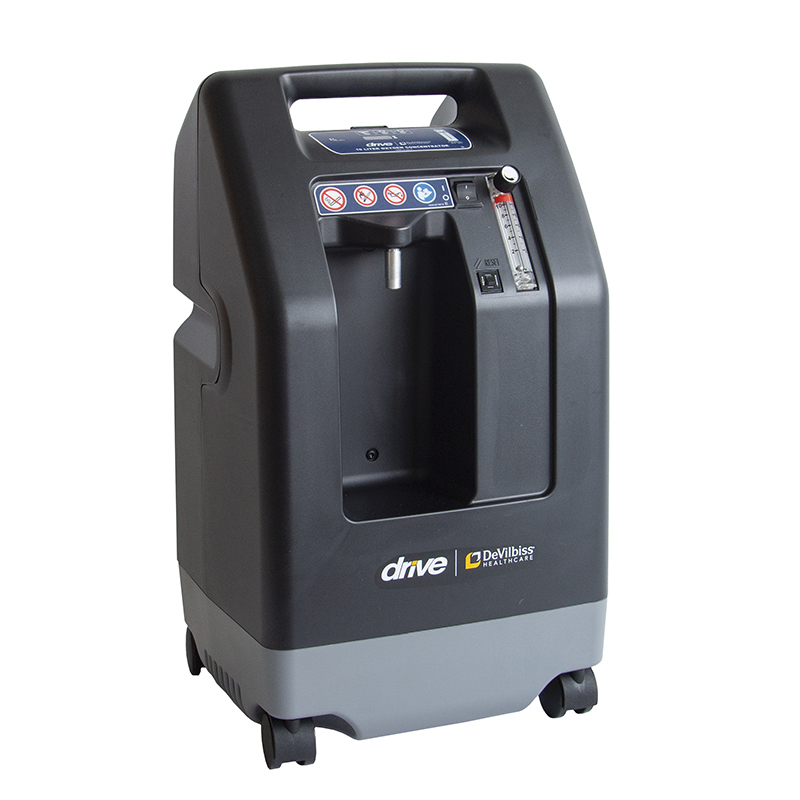CONCENTRATOR O2 (DeVilbiss 1025KS) 10l, 220V + access.
Valid Article
Documents
CONCENTRATOR O2 (DeVilbiss 1025KS) 10l
The model 1025KS replaces the New Life Intensity oxygen concentrator
Definition
A stationary mains electricity (AC-powered) device designed to concentrate oxygen (O2) from ambient air and deliver the concentrated O2, through an attached nasal cannula, to a patient requiring oxygen therapy. It consists of an air compressor, filters, dual chambers, a reservoir and controls. The O2 concentration is variable depending on the flow rate utilized. It is typically wheeled but is designed to be placed in one location.
Synonym
Specifications
Quality standards
Components
- 1 concentrator 1025KS
- 5 outflow connectors HU-2555S
- 1 user's manual
- 5 long term filters 1025D-605
- 1 set pf 6 dust filters 303DZ-605
- 2 antibacterial filters PV5LD-651
Technical specifications
- Oxygen concentration: >90 % ± 3 % with a flow rate of 10 litres/min
- Pressure of oxygen output: 20.0 +/- 1.0 psi (138 kPA +/- 7kPA
- User interface
- easy to operate
- numbers and displays clearly visible and easily readable in low ambient light and sunlight
- Digital or analogue meter that displays cumulative hours of device operation
- Oxygen outlet with 6 mm (1/4 inch) barbed fitting or equivalent
- Flowmeter displaying flowrate
- minimum flow rate of 0.5 l/min or less
- adjustable, within minimum gradation intervals of 1 l/min
- Noise level < 60 dB(A).
- Capable to be disinfected with hospital grade detergents
- Fluid spill resistance: IP21
- Circuit breaker for re-establishing the current following a power surge
- Power switch
- Power supply:3
- Voltage 220-230 V AC, 50 Hz, 3.2Amp
- Input voltage tolerance: 187-255 V
- Average consumption: 670 W
- Operating conditions
- temperature from 10–40°C
- relative humidity from 15–85% (preferably up to 95%)
- Movable with wheels on at least two castors
3-level alarm system
- Sound alarm + flashing light "service required" in case of power failure
- Sound alarm in case the oxygen pressure is below the average (i.e. bended tube, flowmeter < 1 litre/minute or > 5 litres/minute)
- OSD system = continuous monitoring of O2 concentration:
- Green light => concentration > 85 %
- Yellow light => concentration < 85 % (± 2 %)
- Yellow light + sound alarm => concentration < 75 %
Protection against electric shock
- Class II double insulation
- Type B
Dimensions
- Dimensions: 62.2 x 34.2 x 30.4 cm
- Weight: 19 kg
To be Ordered Separately
Don't forget to order the administration devices in sufficient quantities because they are single patient use!
- oxygen masks for adults and children
- nasal oxygen cannula for adults and children
- nasal oxygen cannula for neo-nates and prematures
- oxygen tubes
- pediatric flow splitter Sureflow
See related articles at the end of the technical sheet
Caution, the spare-parts of the different models of De Vilbiss are not always interchangeable!
Instructions for use
Before use, read carefully the user's and maintenance manual (supplied with the concentrator), and the “Respiratory therapy” chapter in the Manual of nursing care procedures, MSF, 2020.
Once the device is turned on, 15 min are necessary to get the maximum level of O2 concentration.
Use of the Airborne module
In case TB patients are suspected: order the airborne module for the O2 concentrator (avoid cross-contamination)
Use of the humidifier (see separate technical sheet)
The humidification of oxygen is recommended in case of prolonged administration in order to prevent the mucous membranes to dry out.
But if the O2 administration is of short duration (few hours), it is better not to use a humidifier.
5 reusable humidifiers (EEMDCONA003) are supplied with the concentrator.
Use of the paediatric flow splitter 'Sureflow' (see separate technical sheet)
This flow-splitter (EEMDCONE007) is more expensive but more reliable than the previous one.
The paediatric flow splitter allows administering O2 to 2, 3 or 4 children simultaneously and to regulate exactly the flow rate for each child. This should be used with nasal cannula's (nasal prongs) and monitored with a pulse oximeter.
To use humidifiers with this flow splitter you have to order male connectors to screw on the top of humidifiers. To have the same number of connectors as humidifiers to screw: order the (paediatric distributor Sureflow) HUMIDIFIERS KIT (EEMDCONA007) which contains all the necessary accessories.
Precautions for Use
- Place the concentrator in a well ventilated area, at least 20 cm away from walls or any other object that might prevent free air flow.
- Protect the concentrator from humidity.
- Protect the O2 source from any flame or spark. Do not smoke nearby.
- Do not to use grease on the connections.
- Do not to use solvent (alcohol, petrol…) on the equipment.
Power supply
The concentrators must work on a stabilized electric supply source.
In case of electric supply problems it is necessary to provide for assistance like a diesel type generator.
Maintenance
The preventive maintenance is simple but must be rigorous (with maintenance logbook):
- Regularly remove the dust from the casing (to unscrew)
- Foam pre-filter:
- clean twice a week
- replace when damaged (minimum once a year)
- Case filter: replace every 3 months (in a dusty environment, check every month)
- Final anti-bacterial filter (inside of the concentrator): replace once a year
- Humidifier: autoclave sterilization between each patient, change the water daily.
It is recommended to have one oxygen analyzer per mission (see related equipment page) .
MSF requirements
Article to replace the New Life Intensity concentrator because of frequent break-downs, expensive spare-parts.
The DeVilbiss is a more reliable apparatus, simple to maintain, with a reactive technical support from the manufacturer.
SPARE-PARTS
The accessories or spare parts of the different models are not always interchangeables!
Check your concentrator model (at the back of the machine) before ordering spare parts!
The model for which a spare part is intended always appears in the label of the article (525KS and/or 1025KS)





![[KMEDKHCX3OP] OPD, COMPLEMENTARY PART observation beds, minimum package](/web/image/product.template/572652/image_256/%5BKMEDKHCX3OP%5D%20OPD%2C%20COMPLEMENTARY%20PART%20observation%20beds%2C%20minimum%20package?unique=f41629f)
![[KMEDKHCX3--] OPD, COMPLEMENTARY PART observation beds](/web/image/product.template/573068/image_256/%5BKMEDKHCX3--%5D%20OPD%2C%20COMPLEMENTARY%20PART%20observation%20beds?unique=e5feae7)
![[KMEDMHIE21-] (mod ICU) EXAMINATION-RESUSCITATION EQUIPMENT](/web/image/product.template/574340/image_256/%5BKMEDMHIE21-%5D%20%28mod%20ICU%29%20EXAMINATION-RESUSCITATION%20EQUIPMENT?unique=22350c3)
![[KMEDMHWE221] (mod ward) COMPLEMENTARY RESUSCITATION EQUIPMENT](/web/image/product.template/572869/image_256/%5BKMEDMHWE221%5D%20%28mod%20ward%29%20COMPLEMENTARY%20RESUSCITATION%20EQUIPMENT?unique=22350c3)
![[KMEDMHOE17-] (mod OT Room) ANESTHESIA-RESUSCITATION EQ.](/web/image/product.template/572539/image_256/%5BKMEDMHOE17-%5D%20%28mod%20OT%20Room%29%20ANESTHESIA-RESUSCITATION%20EQ.?unique=8f85d22)
![[KMEDMHDE31-] (mod delivery & neonate) MEDICAL EQUIPMENT 2021](/web/image/product.template/574359/image_256/%5BKMEDMHDE31-%5D%20%28mod%20delivery%20%26%20neonate%29%20MEDICAL%20EQUIPMENT%202021?unique=de395b9)
![[KMEDMHAE131] (mod AMP) ELECTRICAL MEDICAL EQUIPMENT](/web/image/product.template/568880/image_256/%5BKMEDMHAE131%5D%20%28mod%20AMP%29%20ELECTRICAL%20MEDICAL%20EQUIPMENT?unique=ee5039d)
![[KMEDMHOE11-] (mod OT Room) RECOVERY EQUIPMENT, 2 beds](/web/image/product.template/572534/image_256/%5BKMEDMHOE11-%5D%20%28mod%20OT%20Room%29%20RECOVERY%20EQUIPMENT%2C%202%20beds?unique=fb9a656)
![[KMEDMNUTI35] (module nut. inpatient) RESUSCITATION ITEMS 2021](/web/image/product.template/575291/image_256/%5BKMEDMNUTI35%5D%20%28module%20nut.%20inpatient%29%20RESUSCITATION%20ITEMS%202021?unique=f928ae9)
![[KMEDMHEE321A] (mod emergency) COMPLEMENTARY RESUSCITATION EQUIPMENT 2021](/web/image/product.template/574367/image_256/%5BKMEDMHEE321A%5D%20%28mod%20emergency%29%20COMPLEMENTARY%20RESUSCITATION%20EQUIPMENT%202021?unique=d19c638)
![[EEMDCONA002] (humidifier CH200/TR200) HOSE CONNECTOR 9/16, 920020050](/web/image/product.template/569216/image_256/%5BEEMDCONA002%5D%20%28humidifier%20CH200-TR200%29%20HOSE%20CONNECTOR%209-16%2C%20920020050?unique=937acd4)
![[EEMDCONA003] HUMIDIFIER, autoclavable (FLOWMETER TR200)](/web/image/product.template/571158/image_256/%5BEEMDCONA003%5D%20HUMIDIFIER%2C%20autoclavable%20%28FLOWMETER%20TR200%29?unique=a6e7037)
![[EEMDCONA007] (paediatric distributor Sureflow) HUMIDIFIERS KIT](/web/image/product.template/572248/image_256/%5BEEMDCONA007%5D%20%28paediatric%20distributor%20Sureflow%29%20HUMIDIFIERS%20KIT?unique=36a8e00)
![[EEMDCONC313] (conc. DeVilbiss 525KS/1025KS/DS) ANTIBACT. FILTER PV5LD-651](/web/image/product.template/570091/image_256/%5BEEMDCONC313%5D%20%28conc.%20DeVilbiss%20525KS-1025KS-DS%29%20ANTIBACT.%20FILTER%20PV5LD-651?unique=56d156f)
![[EEMDCONE007] FLOW SPLITTER paediatric (Sureflow FM069-2)](/web/image/product.template/570016/image_256/%5BEEMDCONE007%5D%20FLOW%20SPLITTER%20paediatric%20%28Sureflow%20FM069-2%29?unique=4e06a47)
![[EIMTCONE1--] OXYGEN ANALYSER, 0-10 LPM 21%-95.6%](/web/image/product.template/570085/image_256/%5BEIMTCONE1--%5D%20OXYGEN%20ANALYSER%2C%200-10%20LPM%2021%25-95.6%25?unique=478a81f)
![[EIMTPGAE1--] PRESSURE GAUGE (DeVilbiss PVO2D-601)](/web/image/product.template/570032/image_256/%5BEIMTPGAE1--%5D%20PRESSURE%20GAUGE%20%28DeVilbiss%20PVO2D-601%29?unique=e11cd1e)
![[EEMDCONS1201] (conc. DeVilbiss 1025KS/DS) LONG TERM FILTER 1025D-605](/web/image/product.template/575530/image_256/%5BEEMDCONS1201%5D%20%28conc.%20DeVilbiss%201025KS-DS%29%20LONG%20TERM%20FILTER%201025D-605?unique=f128381)
![[EEMDCONS1202] (conc. DeVilbiss 1025KS/DS) OUTFLOW CONNECTOR HU-2555S](/web/image/product.template/575531/image_256/%5BEEMDCONS1202%5D%20%28conc.%20DeVilbiss%201025KS-DS%29%20OUTFLOW%20CONNECTOR%20HU-2555S?unique=f128381)
![[EEMDCONS1203] (conc. DeVilbiss 1025KS/DS) FILTER COMPRESSOR 1025D-682](/web/image/product.template/575532/image_256/%5BEEMDCONS1203%5D%20%28conc.%20DeVilbiss%201025KS-DS%29%20FILTER%20COMPRESSOR%201025D-682?unique=f128381)
![[EEMDCONS1204] (conc. DeVilbiss 1025KS/DS) ON / OFF BUTTON 1025D-508](/web/image/product.template/575533/image_256/%5BEEMDCONS1204%5D%20%28conc.%20DeVilbiss%201025KS-DS%29%20ON%20-%20OFF%20BUTTON%201025D-508?unique=f128381)
![[EEMDCONS1206] (conc. DeVilbiss 1025KS/DS) CARDBOARD PACKAGING 1025D-606](/web/image/product.template/575497/image_256/%5BEEMDCONS1206%5D%20%28conc.%20DeVilbiss%201025KS-DS%29%20CARDBOARD%20PACKAGING%201025D-606?unique=c6f3080)
![[EEMDCONS1207] (conc. DeVilbiss 1025KS/DS) FLOW METER 10L/min 1025D-607](/web/image/product.template/575534/image_256/%5BEEMDCONS1207%5D%20%28conc.%20DeVilbiss%201025KS-DS%29%20%20FLOW%20METER%2010L-min%201025D-607?unique=f128381)
![[EEMDCONS1208] (conc. DeVilbiss 1025KS/DS) COMPRESSOR BRACKET 1025D-609](/web/image/product.template/575535/image_256/%5BEEMDCONS1208%5D%20%28conc.%20DeVilbiss%201025KS-DS%29%20COMPRESSOR%20BRACKET%201025D-609?unique=8a19ba3)
![[EEMDCONS1209] (conc. DeVilbiss 1025KS/DS) ACCUMULATOR 1025D-610](/web/image/product.template/575498/image_256/%5BEEMDCONS1209%5D%20%28conc.%20DeVilbiss%201025KS-DS%29%20ACCUMULATOR%201025D-610?unique=f128381)
![[EEMDCONS1210] (conc. DeVilbiss 1025KS/DS) PRESSURE REGULATOR 1025D-612](/web/image/product.template/575536/image_256/%5BEEMDCONS1210%5D%20%28conc.%20DeVilbiss%201025KS-DS%29%20PRESSURE%20REGULATOR%201025D-612?unique=f128381)
![[EEMDCONS1211] (conc. DeVilbiss 1025KS) CIRCUIT BREAKER 5A 1025K-613](/web/image/product.template/575537/image_256/%5BEEMDCONS1211%5D%20%28conc.%20DeVilbiss%201025KS%29%20CIRCUIT%20BREAKER%205A%201025K-613?unique=f128381)
![[EEMDCONS1212] (conc. DeVilbiss 1025KS/DS) OVERPRESSURE VALVE 1025D-614](/web/image/product.template/575538/image_256/%5BEEMDCONS1212%5D%20%28conc.%20DeVilbiss%201025KS-DS%29%20OVERPRESSURE%20VALVE%201025D-614?unique=f128381)
![[EEMDCONS1213] (conc. DeVilbiss 1025KS) COMPRESSOR CARTER 1025D-615](/web/image/product.template/575499/image_256/%5BEEMDCONS1213%5D%20%28conc.%20DeVilbiss%201025KS%29%20COMPRESSOR%20CARTER%201025D-615?unique=f128381)
![[EEMDCONS1214] (conc. DeVilbiss 1025KS/DS) PURGE ASSEMBLY 1025D-617](/web/image/product.template/575539/image_256/%5BEEMDCONS1214%5D%20%28conc.%20DeVilbiss%201025KS-DS%29%20PURGE%20ASSEMBLY%201025D-617?unique=f128381)
![[EEMDCONS1215] (conc. DeVilbiss 1025KS/DS) SIEVE, pair 1025D-619](/web/image/product.template/575540/image_256/%5BEEMDCONS1215%5D%20%28conc.%20DeVilbiss%201025KS-DS%29%20SIEVE%2C%20pair%201025D-619?unique=f128381)
![[EEMDCONS1216] (conc. DeVilbiss 1025KS/DS) MOTHERBOARD 1025D-622](/web/image/product.template/575541/image_256/%5BEEMDCONS1216%5D%20%28conc.%20DeVilbiss%201025KS-DS%29%20MOTHERBOARD%201025D-622?unique=b5a8061)
![[EEMDCONS1217] (conc. DeVilbiss 1025KS/DS) TOP COVER LABEL 1025D-631](/web/image/product.template/575500/image_256/%5BEEMDCONS1217%5D%20%28conc.%20DeVilbiss%201025KS-DS%29%20TOP%20COVER%20LABEL%201025D-631?unique=f128381)
![[EEMDCONS1218] (conc. DeVilbiss 1025KS/DS) COMPRESSOR PLATE 1025D-632](/web/image/product.template/575501/image_256/%5BEEMDCONS1218%5D%20%28conc.%20DeVilbiss%201025KS-DS%29%20COMPRESSOR%20PLATE%201025D-632?unique=f128381)
![[EEMDCONS1219] (conc. DeVilbiss 1025KS/DS) 12V FAN 1025D-634](/web/image/product.template/575542/image_256/%5BEEMDCONS1219%5D%20%28conc.%20DeVilbiss%201025KS-DS%29%2012V%20FAN%201025D-634?unique=f128381)
![[EEMDCONS1220] (conc. DeVilbiss 1025KS/DS) METAL TUBE 1025D-655](/web/image/product.template/575502/image_256/%5BEEMDCONS1220%5D%20%28conc.%20DeVilbiss%201025KS-DS%29%20METAL%20TUBE%201025D-655?unique=f128381)
![[EEMDCONS1221] (conc. DeVilbiss 1025KS/DS) COMPRESSOR INTAKE PIPE 1025D-657](/web/image/product.template/575543/image_256/%5BEEMDCONS1221%5D%20%28conc.%20DeVilbiss%201025KS-DS%29%20COMPRESSOR%20INTAKE%20PIPE%201025D-657?unique=f128381)
![[EEMDCONS1222] (conc. DeVilbiss 1025KS) CAPACITOR 1025KS-616](/web/image/product.template/575544/image_256/%5BEEMDCONS1222%5D%20%28conc.%20DeVilbiss%201025KS%29%20CAPACITOR%201025KS-616?unique=f128381)
![[EEMDCONS1223] (conc. DeVilbiss 1025KS) COMPRESSOR SET 1025K-643](/web/image/product.template/575545/image_256/%5BEEMDCONS1223%5D%20%28conc.%20DeVilbiss%201025KS%29%20COMPRESSOR%20SET%201025K-643?unique=5b511e9)
![[EEMDCONS1224] (conc. DeVilbiss 1025KS) COMPRESSOR 1025K-625](/web/image/product.template/575546/image_256/%5BEEMDCONS1224%5D%20%28conc.%20DeVilbiss%201025KS%29%20COMPRESSOR%201025K-625?unique=3f6516f)
![[EEMDCONS335] (conc. DeVilbiss 525KS/1025KS) OUTLET CONNECTOR plast.gre](/web/image/product.template/570086/image_256/%5BEEMDCONS335%5D%20%28conc.%20DeVilbiss%20525KS-1025KS%29%20OUTLET%20CONNECTOR%20plast.gre?unique=6feefa9)
![[EEMDCONS401] (conc. DeVilbiss 525KS/1025KS) DUST FILTER 303DZ-605](/web/image/product.template/570623/image_256/%5BEEMDCONS401%5D%20%28conc.%20DeVilbiss%20525KS-1025KS%29%20DUST%20FILTER%20303DZ-605?unique=514f368)
![[SCTDCANN2A-] NASAL OXYGEN CANNULA, 2 prongs + tube, adult](/web/image/product.template/571896/image_256/%5BSCTDCANN2A-%5D%20NASAL%20OXYGEN%20CANNULA%2C%202%20prongs%20%2B%20tube%2C%20adult?unique=0a028ad)
![[SCTDCANN2N-] NASAL OXYGEN CANNULA, 2 prongs + tube, neonate](/web/image/product.template/571935/image_256/%5BSCTDCANN2N-%5D%20NASAL%20OXYGEN%20CANNULA%2C%202%20prongs%20%2B%20tube%2C%20neonate?unique=0a028ad)
![[SCTDCANN2P-] NASAL OXYGEN CANNULA, 2 prongs + tube, paediatric](/web/image/product.template/571930/image_256/%5BSCTDCANN2P-%5D%20NASAL%20OXYGEN%20CANNULA%2C%202%20prongs%20%2B%20tube%2C%20paediatric?unique=0a028ad)
![[SCTDCANN2PL] NASAL OXYGEN CANNULA, 2 prongs + tube, premature low flow](/web/image/product.template/571931/image_256/%5BSCTDCANN2PL%5D%20NASAL%20OXYGEN%20CANNULA%2C%202%20prongs%20%2B%20tube%2C%20premature%20low%20flow?unique=56d156f)
![[SCTDCONN4S-] CONNECTOR, Y-shaped, ext. Ø 4 to 5 mm, autoclavable](/web/image/product.template/571858/image_256/%5BSCTDCONN4S-%5D%20CONNECTOR%2C%20Y-shaped%2C%20ext.%20%C3%98%204%20to%205%20mm%2C%20autoclavable?unique=0a028ad)
![[SCTDCPAP202] CPAP O-Two single use SET, mask n°3 child, + manometer](/web/image/product.template/574008/image_256/%5BSCTDCPAP202%5D%20CPAP%20O-Two%20single%20use%20SET%2C%20mask%20n%C2%B03%20child%2C%20%2B%20manometer?unique=f128381)
![[SCTDCPAP203] CPAP O-Two single use SET, mask n°4 adult, + manometer](/web/image/product.template/574007/image_256/%5BSCTDCPAP203%5D%20CPAP%20O-Two%20single%20use%20SET%2C%20mask%20n%C2%B04%20adult%2C%20%2B%20manometer?unique=9488726)
![[SCTDCPAP204] CPAP O-Two single use SET, mask n°5 Large adult, + manometer](/web/image/product.template/574006/image_256/%5BSCTDCPAP204%5D%20CPAP%20O-Two%20single%20use%20SET%2C%20mask%20n%C2%B05%20Large%20adult%2C%20%2B%20manometer?unique=f128381)
![[SCTDMASO1A-] OXYGEN FACE MASK, simple, with tubing, adult size](/web/image/product.template/572292/image_256/%5BSCTDMASO1A-%5D%20OXYGEN%20FACE%20MASK%2C%20simple%2C%20with%20tubing%2C%20adult%20size?unique=5befc85)
![[SCTDMASO1P-] OXYGEN FACE MASK, simple, with tubing, paediatric size](/web/image/product.template/572294/image_256/%5BSCTDMASO1P-%5D%20OXYGEN%20FACE%20MASK%2C%20simple%2C%20with%20tubing%2C%20paediatric%20size?unique=0a028ad)
![[SCTDMASOH1A] OXYGEN FACE MASK, non-rebreathing + tubing, adult](/web/image/product.template/572299/image_256/%5BSCTDMASOH1A%5D%20OXYGEN%20FACE%20MASK%2C%20non-rebreathing%20%2B%20tubing%2C%20adult?unique=93982ba)
![[SCTDMASOH1P] OXYGEN FACE MASK, non-rebreathing + tubing, paediatric](/web/image/product.template/572290/image_256/%5BSCTDMASOH1P%5D%20OXYGEN%20FACE%20MASK%2C%20non-rebreathing%20%2B%20tubing%2C%20paediatric?unique=0a028ad)
![[SCTDTUOX10-] TUBE, OXYGEN, conical tip, 40 cm, s.u., CH 10](/web/image/product.template/572742/image_256/%5BSCTDTUOX10-%5D%20TUBE%2C%20OXYGEN%2C%20conical%20tip%2C%2040%20cm%2C%20s.u.%2C%20CH%2010?unique=9285296)